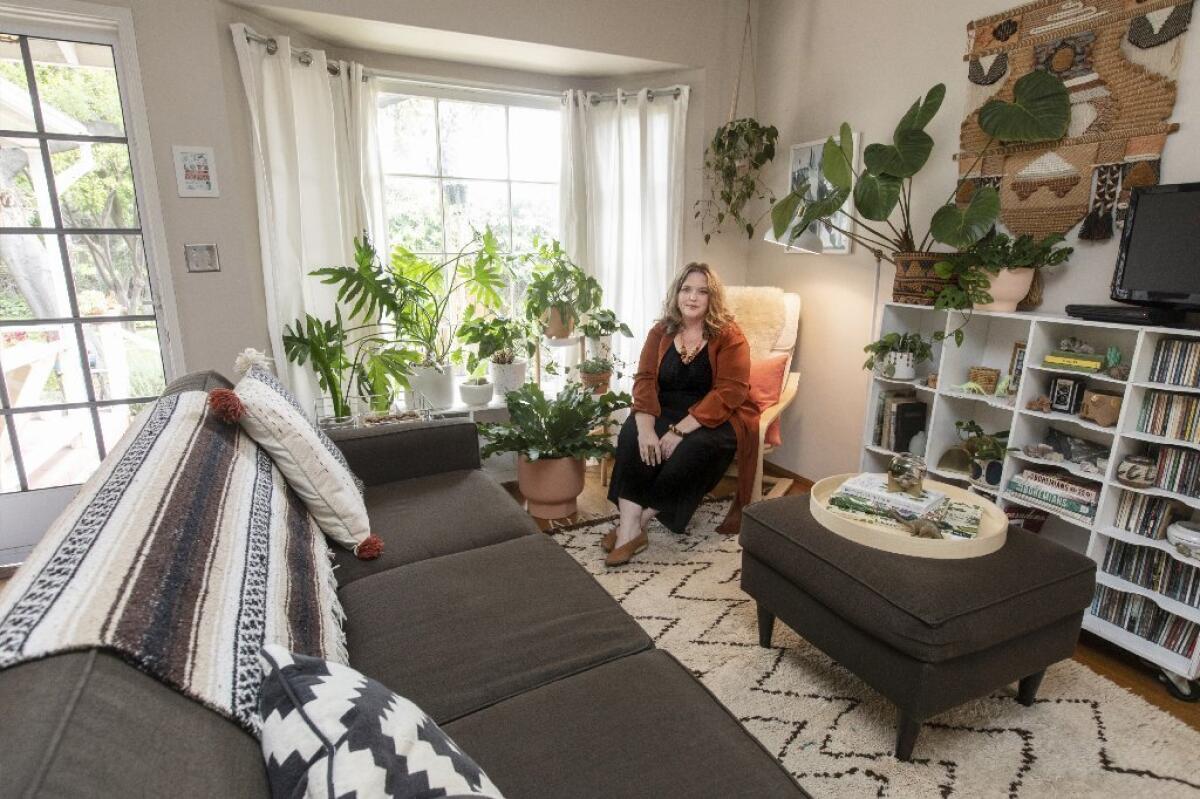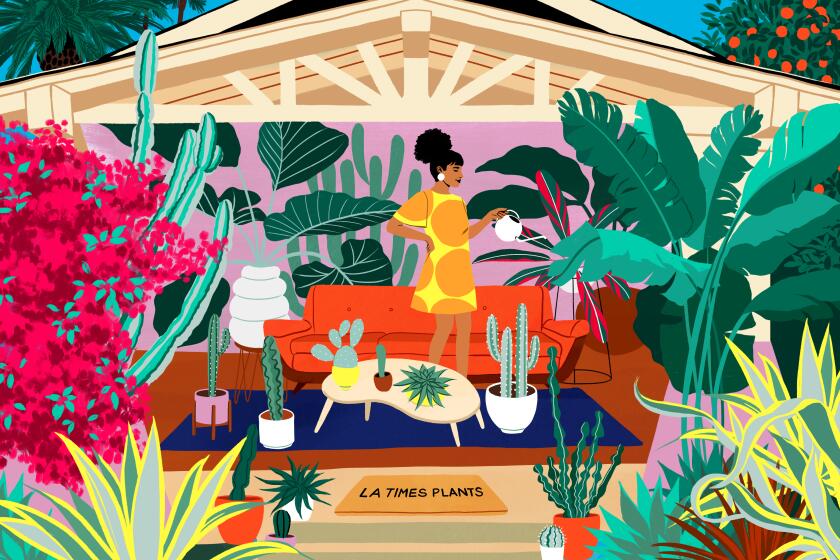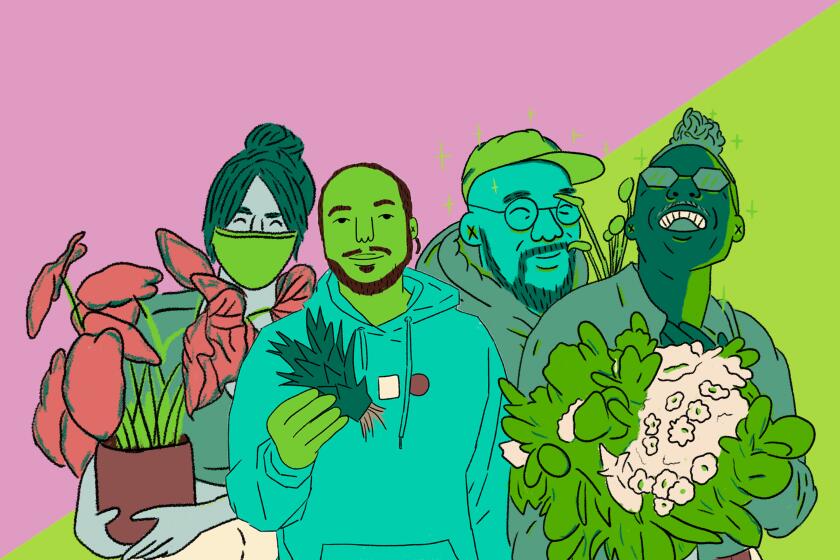Yes, your houseplants can thrive. An expert shares how in her new book
- Share via
On paper, it seems so easy: Give your houseplants water and sunlight, and they’ll flourish.
So why is it so hard for some of us to keep our houseplants alive?
“Plants are living things with needs,” explained Los Angeles plant expert Danae Horst, author of the new book “Houseplants for All: How To Fill Any Home With Happy Plants” (Houghton Mifflin Harcourt, $20).
Get The Wild newsletter.
The essential weekly guide to enjoying the outdoors in Southern California. Insider tips on the best of our beaches, trails, parks, deserts, forests and mountains.
You may occasionally receive promotional content from the Los Angeles Times.
Anyone can be a plant person, Horst said, as long as they choose plants well-suited to their home and lifestyle.
“I wanted to write a book that would help people understand that their space is the most important piece in why their plant is thriving or not thriving,” Horst continued. “It’s one thing to fill a room with plants, but if it’s the wrong room, the plants won’t flourish.”
Horst grew up going to nurseries and greenhouses with her mother in Wyoming and turned her fascination with plants into a lifelong vocation, having worked as a plant stylist for Justina Blakeney’s popular Jungalow blog and as the owner of the plant boutique Folia Collective in Eagle Rock.
Thirsty? Lack of light? Need to get rid of gnats? Here are the answers to the most frequently asked questions about houseplants.
“Danae’s passion for plants is multifaceted and deep,” Blakeney said recently. “Not only is she expert in caring for plants and understanding their wants and needs, but her trained eye for design paired with her expert plant knowledge means that she really knows how to create dynamic plant pairings and installations that thrive. Danae is a researcher and seeker so she also knows about weird, cool, unusual plants that I love. Her background as a stylist and photographer also means that she really gets how to work with plants in the home.”
In her new book, Horst has created an introduction to houseplants that plant parents can refer to time and time again, including plant care basics, placement and styling tips, detailed plant profiles and inspiring house tours.
In our Plant PPL series, we interview people of color in the plant world, including plantfluencers, plant stylists, floral artists, enthusiasts, experts and garden store owners.
“I hate to see people kill plants and get discouraged,” Horst said. “ So many people think they have a ‘black thumb’ and can’t keep plants alive. I want to set people up for success.”
Horst’s book was scheduled to come out in April, but because of the COVID-19 pandemic, it was postponed to August. Here, she shares why she wrote the book and how you can have happy plants too.
Why did you write this book?
I wanted to create a resource that people can keep going back to when they have a problem. I also wanted it to be beautiful and inspiring.
What’s the most common mistake people make with houseplants?
Not thinking about their living spaces when they purchase their plants. What does the plant need in terms of light? They need to figure out what they can provide for them at home. Some plants need more than just a basic home environment. That’s why I include ID and care cards with all of my plants at Folia Collective. I don’t understand how people can sell plants without giving people information. A lot of times they don’t know the name of the plant. How are they going to know what to do with it? People need to be able to research their plants when they get home.
How did you select the individual plants you profiled in the book?
I tried to choose a mix of plants that people could afford and find. I tried not to pick rare plants.
I loved the styling tips.
There is an element to styling that is instinct, but I believe there are basic principles that people who have a good eye for styling follow. I tried hard to instill those concepts into something that was executable. Even if readers use a few of these tips, they can make a vignette or transform a corner to achieve a style that they might admire on Instagram.
How has the pandemic affected you?
Weirdly, the pandemic has been good for us. The store is much busier than normal. Everyone is crazy about plants right now. We offer curbside pickup and local delivery. The store feels like a plant warehouse, and it has been exhausting. But I think the timing is good for the book because people have been bringing more plants into their homes and have no idea what they are doing.
What do you think of the COVID-induced houseplant craze?
I’ve been doing this since 2016, and I do think that there’s something happening right now, due to the pandemic, that is a trend. I think people are sitting at home, looking at their spaces and realizing that the element that might be missing is plants. It’s an affordable way to add vibrancy. People can buy a handful of plants for $100 and transform a corner in their home. The affordability of plants comes at a time when people are more money conscious. When people see something on Instagram, it’s going to inspire them to jump on the trend train. But there is an element of hard work involved when it comes to plants, and not everyone is going to be up for that. Plants have made a resurgence over the last decade because a generation who grew up without them has reconnected with the wonder of plants and the way they can transform a space.
How did you choose the houses you featured?
I picked the houses initially by their environment (bright and sunny, lower light, humid, indoor-outdoor and shifting light). I also chose homes that were pretty and inspiring but not unattainable. Sometimes plant books have these gorgeous homes that don’t look like real-life, regular people’s homes. It was fun because a lot of the homes that I featured were people that I had a relationship with. It was a fun celebration of the community.
Cactus, succulents, herbs, dwarf citrus and other houseplants that can handle the summer heat.
Do people talk to you about their houseplants like their children?
Anytime I tell people what I do, they usually have some kind of a story about their mom or their grandmother or their sick plant at home or work. I spend a lot of my free time talking about plants.
While I have you, I have to ask: When leaves turn brown, it’s either a) you’re watering too much or b) you’re not watering enough. How do you know?
[Laughter] By thinking back to what you have been doing. People usually know. There are more questions involved, and it could be a number of things. It’s the same thing with yellowing.

More to Read
Sign up for The Wild
We’ll help you find the best places to hike, bike and run, as well as the perfect silent spots for meditation and yoga.
You may occasionally receive promotional content from the Los Angeles Times.














